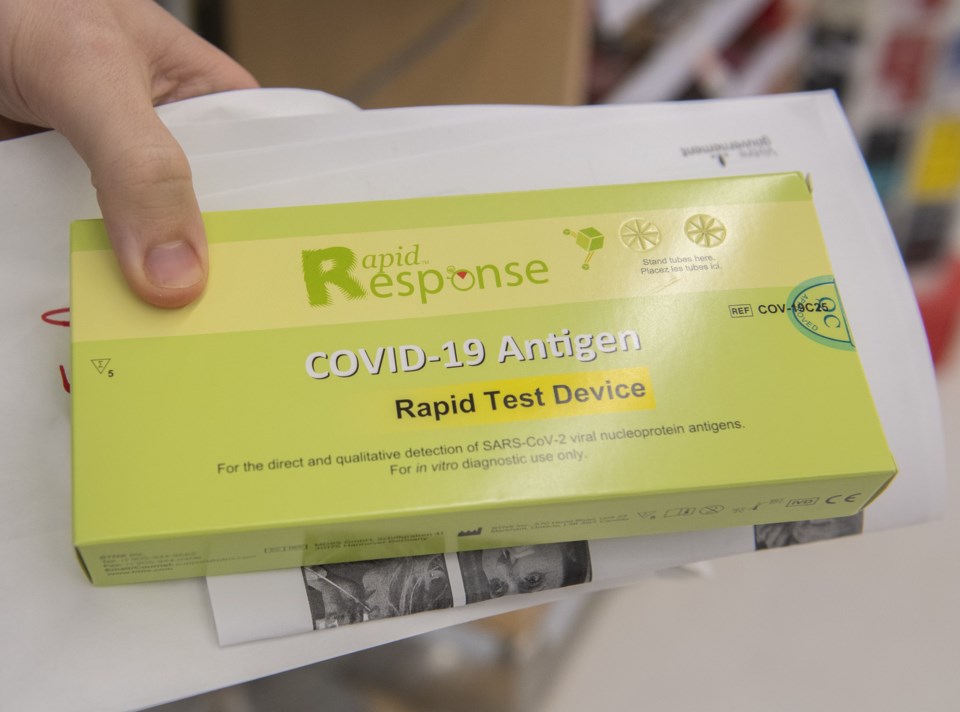Recent social media posts have fed into the notion that swabbing the throat with a COVID-19 rapid antigen test kit might yield more accurate results against the Omicron variant than only testing for virus in the nostrils.
But many experts are raising concerns with that approach, warning that diverging from a device's intended use could produce false results.
Earl Brown, a microbiology and immunology professor at the University of Ottawa, says even if Omicron is more detectable in the throats of some people, rapid tests should be used as directed.
"These tests are developed and certified as nasal tests — they are medical equipment," Brown said.
"You can't just say through a press release or something that the test will now be used differently. It hasn't been approved for that."
Brown said tests that change their directions would have to be revalidated by manufacturers and gain approval from governing bodies.
Even then, Brown cautioned, swabbing the throat could potentially change the test's effectiveness if it dilutes the nasal sample, or if food or drink particles became mixed with saliva.
He added that teenagers on Tiktok have shown false positives when soda is mixed with the sample, messing with its pH and skewing results.
While saliva tests do exist for certain pathogens, including some COVID-19 rapid tests, Brown said those typically include directions to not eat or drink anything for a period of time before taking them.
"With the nose, we know the chemistry, it doesn't change much," Brown said. "But with a saliva sample, you've got all the problems of eating and drinking, maybe smoking, all that changes the chemistry."
Health Canada said in an emailed statement Monday that medical devices, including the country's supply of COVID-19 rapid tests, are approved to be used "as recommended by the manufacturer."
The agency's guidance is to "use (the tests) as directed," but it added that provinces and territories are able to offer their own guidance "outside the scope of the product's label."
Recommendations from many jurisdictions mirrored that of the national body as of Tuesday, however.
The Nova Scotia Health Authority said self-administered rapid tests in the province are designed for nasal sampling, recommending people "accurately follow the directions provided." The organization said their position will continue "unless we get direction to change collection from the test manufacturer, from Health Canada, or through some other means supported by data."
Manitoba urges people to follow directions on their tests, noting on its website that different types may carry different instructions. The province warns that not following directions "including not waiting long enough or waiting too long to read the test result" can lead to incorrect diagnoses.
Alberta's health website, meanwhile, includes an instructional video from Rapid Response on how to use their specific nasal-swab tests. The video shows the swab used in both nostrils, with no mention of swabbing the throat.
Other countries have rapid tests that are meant for use in both the nose and the throat, however.
A video from Public Health England demonstrates how to use a specific test where a "combined sample" is needed. The results are meant to be sent to a lab for analysis.
While experts say Omicron could be more detectable in the throats of some people, others will find higher concentration of the virus in their noses. And some may not have high enough levels to be detected by rapid tests at all.
Eric Arts, an immunology professor at Western University and a researcher in viral control, said in an email "there is no special formula" to determine optimal swab location, adding that while a positive result is likely accurate, a negative one doesn't mean the person is clear of COVID-19.
He said many people get negative results on rapid tests before testing positive days later.
"If you have cold-like symptoms right now, you should assume you are infected with Omicron and confirm by testing every day or two," Arts said.
"Basically, a positive rapid test ... only turns positive when you have high levels of Omicron replication, which unfortunately may take several days to develop and then detect."
The U.S.-based CDC says on its website the accuracy of rapid tests "largely depend on the circumstances in which they are used," adding they work best if people test when their viral load is highest.
The CDC says their tests are currently authorized for nasal use.
Cynthia Carr, an epidemiologist in Winnipeg, said if the virus is changing so that higher concentrations are found in the throat, new tests should be authorized with instructions for that area.
But collecting proper throat samples at home could be problematic, she said, noting it may be harder to hold the test in the throat long enough or to "differentiate between being in the mouth, back of the mouth and actual throat."
"So even if more virus is detectable, if (you're) ... doing it improperly, you may end up with more wasted tests with false negatives."
This report by The Canadian Press was first published Jan. 12, 2022.
Melissa Couto Zuber, The Canadian Press



